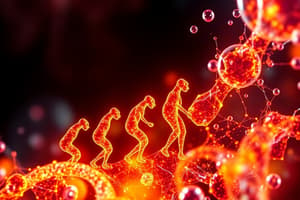Podcast
Questions and Answers
What type of environment is suggested for the formation of the first cells?
What type of environment is suggested for the formation of the first cells?
- Liquid water at varying temperatures
- Liquid water but not too hot (correct)
- High-pressure gas environments
- Solid ice under extreme cold
Which organic molecules are proposed as part of the first cells' hereditary material?
Which organic molecules are proposed as part of the first cells' hereditary material?
- C, N, O, S, and P (correct)
- Proteins and lipids
- Simple hydrocarbons
- Sugars and amino acids
What role did ribozymes play in the RNA world model?
What role did ribozymes play in the RNA world model?
- They were solely responsible for energy production
- They served as catalysts, exhibiting enzymatic properties (correct)
- They facilitated cellular respiration
- They were the first forms of DNA
What is a clade in a phylogenetic context?
What is a clade in a phylogenetic context?
What does the phylogeny of a species describe?
What does the phylogeny of a species describe?
What essential element is NOT mentioned as a requirement for the evolution of the first cells?
What essential element is NOT mentioned as a requirement for the evolution of the first cells?
Which energy source is primarily responsible for supporting the conditions necessary for life to emerge?
Which energy source is primarily responsible for supporting the conditions necessary for life to emerge?
What is the main type of fossil evidence that suggests the existence of early life forms?
What is the main type of fossil evidence that suggests the existence of early life forms?
What gases were primarily released into Earth's atmosphere during early volcanic activity?
What gases were primarily released into Earth's atmosphere during early volcanic activity?
Which of the following is considered convincing evidence for early microbial life?
Which of the following is considered convincing evidence for early microbial life?
The earliest accepted microfossils are dated to how many years ago?
The earliest accepted microfossils are dated to how many years ago?
Colonial cyanobacteria are associated with which significant period in early life development?
Colonial cyanobacteria are associated with which significant period in early life development?
Which condition would likely prevent the emergence of metabolic reactions necessary for life?
Which condition would likely prevent the emergence of metabolic reactions necessary for life?
What mechanism does NOT contribute to the divergence of populations through evolution?
What mechanism does NOT contribute to the divergence of populations through evolution?
Which molecular clock is most commonly used for studying evolutionary time?
Which molecular clock is most commonly used for studying evolutionary time?
Which of the following statements about molecular clocks is accurate?
Which of the following statements about molecular clocks is accurate?
What defines a rooted phylogenetic tree?
What defines a rooted phylogenetic tree?
Which types of genes provide the most consistent measures of evolutionary time?
Which types of genes provide the most consistent measures of evolutionary time?
Why is a larger amount of sequence necessary for constructing a phylogenetic tree?
Why is a larger amount of sequence necessary for constructing a phylogenetic tree?
What is the result of reductive evolution in a genetic context?
What is the result of reductive evolution in a genetic context?
What is a significant factor that can affect the results of phylogenetic calculations?
What is a significant factor that can affect the results of phylogenetic calculations?
What is the primary focus of phylogenetic trees?
What is the primary focus of phylogenetic trees?
What role does natural selection play in evolution?
What role does natural selection play in evolution?
What is one of the methods to study mechanisms of natural selection?
What is one of the methods to study mechanisms of natural selection?
How is a species defined among macro-eukaryotes?
How is a species defined among macro-eukaryotes?
What distinguishes microbial species from macro-eukaryotic species?
What distinguishes microbial species from macro-eukaryotic species?
What does taxonomy involve?
What does taxonomy involve?
What are the three key components of taxonomy?
What are the three key components of taxonomy?
What is currently a challenge in naming newly discovered microorganisms?
What is currently a challenge in naming newly discovered microorganisms?
Flashcards are hidden until you start studying
Study Notes
Origins of Life
- Essential elements for life: Carbon, Nitrogen, Oxygen, Sulfur needed for organic molecules.
- Energy sources: Nuclear fusion from the Sun and photosynthesis crucial for sustaining life.
- Liquid water exists within a specific temperature range, allowing metabolic reactions to occur without breaking down macromolecules.
Early Life
- Stromatolites are the earliest fossil evidence of life, dating back 3.4 billion years, comprising layered sedimentary structures.
Earth’s Atmosphere
- The initial atmosphere formed from volcanic gases, predominantly Carbon Dioxide and Nitrogen.
- Life evolved, contributing Nitrogen (N2) and Oxygen (O2) back into the atmosphere.
Geological Evidence for Early Life
- Biosignatures are indicators of life in geological records, such as specific lipid compositions in bacterial membranes.
- Evidence includes isotope ratios, stromatolites, and microfossils.
Microfossils
- The earliest accepted microfossils are filamentous prokaryotes and colonial cyanobacteria, dated at 2.0 billion years ago.
- Fossils from 1.2 billion years ago show larger cells akin to modern eukaryotic algae.
Forming the First Cells
- Early cellular models considered environments for cell formation, energy metabolism, and hereditary materials.
- Liquid water was essential for metabolic functions and the stability of macromolecules, with energy primarily from sunlight.
The Prebiotic Soup
- Simple organic molecules formed abiotically due to lightning striking reduced chemicals, leading to complex macromolecules with self-replicating ability.
The RNA World
- RNA served double roles in early life, functioning both informationally and catalytically, similar to DNA and proteins today.
- Ribozymes demonstrated enzymatic properties, indicating RNA's early role in biochemical processes.
Evolution: Phylogeny
- Clades represent groups sharing a common ancestor, forming monophyletic groups that branch into more species.
- Phylogeny is the complete description of species’ evolutionary divergences.
Divergence through Mutation and Natural Selection
- Evolutionary divergence occurs through random mutations, natural selection favoring reproductive success, and reductive evolution where less favorable traits diminish.
Molecular Clocks
- Molecular clocks estimate evolutionary time through random mutations during DNA replication.
- Ribosomal RNA, tRNA, and RNA polymerase genes are most reliable for measuring evolutionary time.
- Small subunit rRNA (16S for bacteria, 18S for eukaryotes) is a common molecular clock.
Phylogenetic Trees
- Phylogenetic trees can be rooted or unrooted, indicating or not indicating a common ancestor.
- These trees can compare organisms from various environments and habitats.
Natural Selection and Adaptation
- Evolution enables survival in new environments via variant adaptations leading to natural selection.
- Mechanisms studied through genomic analysis, selective environments, and experimental evolution in laboratories.
Microbial Species and Taxonomy
- A species in macro-eukaryotes includes individuals capable of interbreeding, while microbial species often defined by asexual reproduction.
- Microbial classification may depend on shared genetic and ecological characteristics.
Classification and Nomenclature
- Taxonomy involves classifying life forms based on shared traits, including classification, nomenclature, and identification.
- It establishes a hierarchical structure for categorizing organisms.
Emerging Clades: Unclassified and Uncultured Bacteria
- The classification of newly discovered microorganisms relies on genetic similarities and ecological characteristics.
Studying That Suits You
Use AI to generate personalized quizzes and flashcards to suit your learning preferences.





